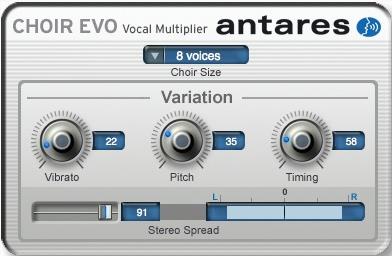I was practicing Purcell's "Dido's Lament" (an excellent and rather easy piece for theremin - and one of the top 5 classical loops I talked about in my other post on looping) and had a thought. I have a new voice doubler that might be interesting to use here.
Voice doublers are basically delays that create the impression that there are more of you singing/playing than there are. Reinforces the sound and very commonly used in the studio and on stage. Normally doubling you at pitch, but they can change octaves and even start adding intervals (but then soon turn more into harmonizers). Pitch shifters can create similar effects and sometimes the two effects are combined. Actually, most vocal processors have a number of doubling effects. Some, as I'll discuss here, have special purpose functions.
I was thinking, I'm getting much better playing in tune, but am still a bit off here and there. What other "instrument" is in a constant state of being out of tune? A choir! Everyone is slightly out of tune but when it all comes together that negative on the individual level is turned into a major positive when everyone sings as a group (provided they are not that much out of tune of course). Those slight differences in pitch, timing and tone create a very complex sound.
So what would happen if I recorded a number of takes of the piece and applied my new Antares Choir EVO Vocal Multiplier plug-in on each voice in different ways? Antares is selling their voice plugins - a new plug-in deal for $24 every month now ($24 in 24 hours they say - they give you a day to buy). For $24 it's a steal so I've been buying them. Choir EVO is part of the larger Antares AVOX Vocal Kit - that you can buy as a package if you like - but they appear to be selling off pieces cheaply as noted (vs. orig $69) so if you see one of these effects you like, you can pick it up without breaking your wallet.
This "Vocal Multiplier" is interesting. It focuses on a single effect but it has a unique feature that lets you set how many voice doublings/multipliers you want 4, 8, 16, 32. Kind of the mother of all vocal doublers - as it's intended to create a choir-like effect. It also lets you alter detuning (set range of variation of pitch in the voices), set the range of vibrato depth on the voices, and lets you play with the stereo separation of the voices. It does add a bit of noise to the lines but used to create a background setting, its fine. The User Interface is simple and clean.

I played in the Purcell melody a number of times using my Etherwave plus (set to a more sine-like setting) and then set convolution reverb on each voice along with the Choir EVO plug-in and panned them all differently in the stereo field. I also copied a few voices in the DAW as well in this manner to add a bit more doubling (there were a total of seven theremin tracks used). Then I set all the voices to different Choir EVO doublings and settings above a sampled string arrangement I made (that's pretty true to the original string parts - I got from IMSLP.org) - used a combination of East West Symphonic Orchestra strings and 8DIO Adagio String Library. These are pretty cinematic libraries so I really took this out of the ream of it's original simple Baroque string setting (sorry if you are a Baroque purist). Finally, I added a stereo widening plug-in on the mix for a bit more vocal depth and compressed things a bit.
Baroque Performance Note: Baroque music really does not emphasize vibrato and in general keeps dynamics at a more or less consistent level (unless a special terraced effect is called for). So I did not try and vary dynamics that much. But I added a bit of rubato here and there. (Played as a theremin solo I've found it's more difficult if you try and limit vibrato of course)
Anyway, an interesting choral sounding effect resulted, and as would occur in a choir, some of my pitch imperfections are obscured being blended into the whole. In some places, it's very choir-like. Perhaps not that useful in and of itself, but I may want to create a theremin solo over a choir (and now I can figure out how to do that just using the theremin instead of choir samples). It does create a rather unearthly choral effect, as I was hoping. Might be even more realistic if I slightly change the tone knobs for each take. Could also try adding standard chorus effects.
The sound file for the experiment described above is here:
So in addition to that Voice Box effect, we can get a pretty useful choral effect now too if needed (though I assume others have used similar techniques).
Rich


